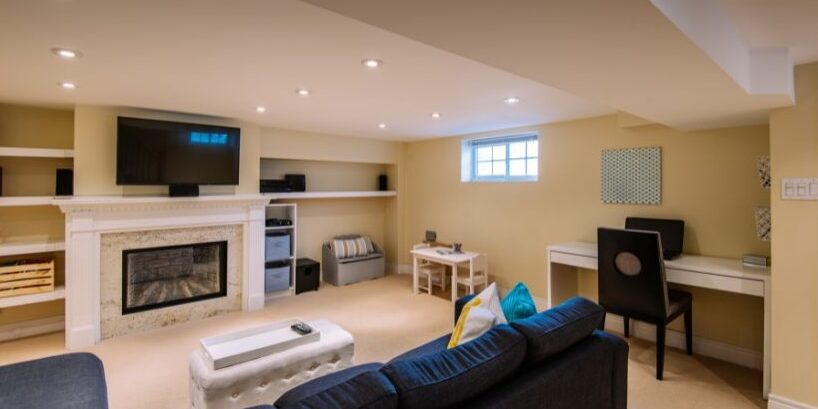Why Basement Lighting Matters
Good lighting does more than help you see — it affects how you feel. In a below-ground room, strategic lighting can make ceilings seem higher, corners wider, and the entire atmosphere more uplifting. It’s not just about brightness; it’s about layering and tone.
| Lighting Benefit | Impact |
|---|---|
| Layered Illumination | Combines ambient, task, and accent lighting to eliminate shadows and add depth. |
| Improved Mood | Warm light mimics sunlight, improving comfort and productivity. |
| Enhanced Design | Highlight architectural details, artwork, or textures to elevate the overall look. |
| Better Functionality | Different lighting zones adapt to how you actually use the space — work, play, or relax. |
1. Recessed LED Ceiling Lights
Recessed LEDs are the backbone of modern basement lighting. They’re low-profile, energy-efficient, and evenly distribute light across the room. Install them in a grid layout to eliminate dark zones and give the illusion of higher ceilings.
- Choose 4000–5000K color temperature: Mimics natural daylight for a bright, balanced glow.
- Use dimmers: Lets you adjust brightness depending on time of day or activity.
- Space lights 4–6 feet apart: Ensures consistent coverage without harsh glare.
Pro Tip: Opt for adjustable gimbal LEDs to spotlight art, seating areas, or accent walls.
2. Wall Sconces for Warmth and Depth
Wall sconces break up large, flat walls and add a cozy, architectural touch. They’re perfect for basements with low ceilings, providing lateral light that softens shadows and enhances the space’s vertical dimension.
- Mount sconces 60–66 inches from the floor: Keeps the light eye-level and balanced.
- Pair with dimmable switches: Ideal for theaters, lounges, and bedrooms.
- Choose warm finishes: Matte black, brass, or bronze complement modern basement palettes.
Pro Tip: Combine wall sconces with cove or floor lighting to layer warmth from multiple angles.
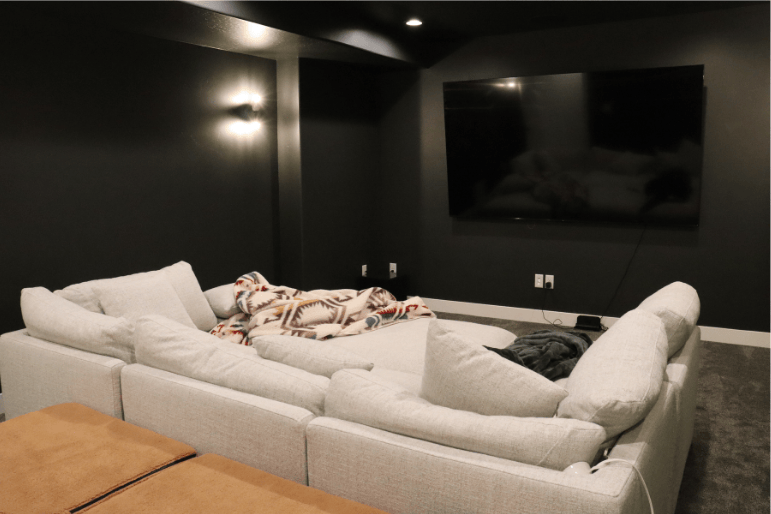
3. Cove Lighting for a Floating Ceiling Effect
Cove lighting adds a high-end architectural feel by hiding LED strips behind moldings or ceiling drops. The light washes up onto the ceiling, creating a floating effect that visually expands the space.
- Use 3000K warm-white LEDs: Soft glow ideal for media or relaxation spaces.
- Install dimmable RGB strips: Lets you change color for movie nights or parties.
- Hide wiring in ceiling recesses: Clean finish with zero visible cables.
Pro Tip: Combine cove lighting with recessed LEDs for a luxurious layered look often seen in high-end theaters or gyms.
4. Pendant Lights for Personality
Pendants bring design flair to areas like basement bars, reading corners, or stairways. They draw the eye downward, creating intimacy and defining zones within open layouts.
- Hang pendants 28–34 inches above countertops: Perfect height for task lighting at bars or kitchenettes.
- Cluster small pendants: Add dimension to larger rooms.
- Choose clear glass or open shades: Keeps light distribution even and bright.
Pro Tip: Pair pendants with recessed lighting for balance — style meets function.
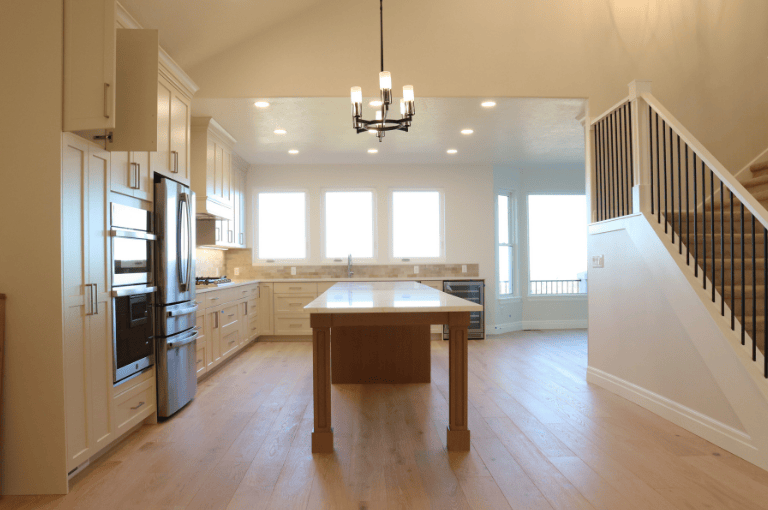
5. Track Lighting for Flexibility
Track lighting is ideal when you need versatility. It allows you to direct light exactly where you want — great for highlighting artwork, shelving, or activity areas.
- Use adjustable heads: Re-aim them when furniture layouts change.
- Mix spot and flood bulbs: Control both broad light and focal points.
- Choose matte white tracks: Blend seamlessly into ceilings.
Pro Tip: In low ceilings, use slim, linear track systems to avoid visual clutter.
6. Floor and Table Lamps for Layered Ambience
Freestanding lighting adds warmth and flexibility. Floor and table lamps are especially useful for reading nooks, lounges, or offices within your basement.
- Use fabric or frosted shades: Diffuses light softly to reduce harsh contrast.
- Mix heights and bulb types: Creates dynamic visual layering.
- Opt for smart bulbs: Control color and brightness by app or voice.
Pro Tip: Place lamps near reflective surfaces or mirrors to multiply light output.
7. Under-Cabinet and Shelf Lighting
Perfect for basement bars, offices, or display shelves, under-cabinet lighting adds subtle glow while improving task visibility. It also gives cabinetry a custom-built, high-end look.
- Use LED strip lights: Discreet, long-lasting, and energy-efficient.
- Choose 2700K–3000K warm light: Enhances wood tones and décor.
- Add motion sensors: Great for bars or stairways — instant illumination on approach.
Pro Tip: Hide LED strips behind trim for an elegant, “floating” cabinet effect.
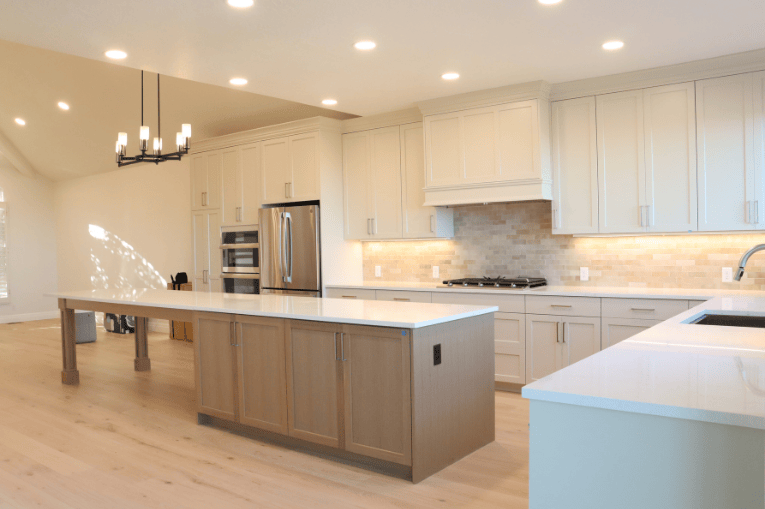
8. Natural Light Enhancers: Egress Windows and Light Wells
If your basement layout allows, adding an egress window or light well can transform everything. They introduce true daylight, ventilation, and safety compliance for living spaces.
- Install egress windows strategically: Near main seating or office zones for brightness.
- Use reflective window wells: Bounce sunlight deeper into the room.
- Pair with white or pale walls: Amplifies natural light penetration.
Pro Tip: Combine natural light with layered artificial lighting for balance through all hours.
9. Mirror and Surface Reflection Tricks
Light-colored walls, glass décor, and mirrors can visually double brightness. When used strategically, they extend illumination across corners and hidden areas.
- Place mirrors opposite light sources: Maximizes reflection and depth.
- Use semi-gloss finishes: Reflects light without feeling harsh or clinical.
- Choose light-toned flooring: Helps bounce light upward.
Pro Tip: A large wall mirror opposite recessed lights can make a basement feel twice as spacious.
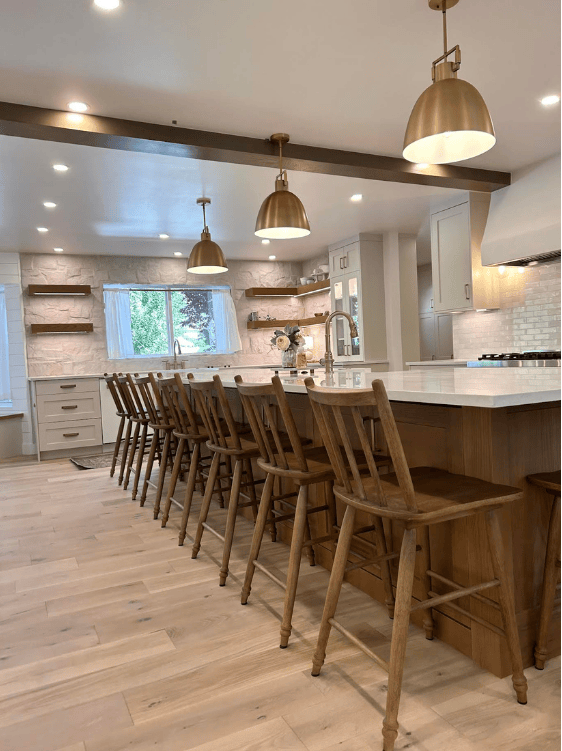
10. Smart Lighting Systems
Smart technology brings your basement lighting to life — literally. Automated systems let you change brightness, color, and mood from your phone or voice assistant.
- Pre-set “scenes”: Create settings for movie night, workouts, or work time.
- Energy efficiency: Schedule lights to turn off automatically when not in use.
- Full control: Adjust color temperature to match daylight cycles.
Pro Tip: Integrate smart lighting with your home automation system for seamless, hands-free operation.
Basement Lighting Cost Breakdown
According to Angie, the average basement lighting installation costs between $1,500 and $7,000, depending on size, layout, and fixture type. Adding egress windows or cove lighting can increase the total investment but dramatically improve comfort and resale value.
| Feature | Average Cost (USD) | Notes |
|---|---|---|
| Recessed Lighting Installation | $800 – $2,000 | Depends on number of fixtures and ceiling type. |
| Wall Sconces or Pendant Lights | $200 – $600 per fixture | Includes wiring and mounting. |
| LED Strip or Cove Lighting | $400 – $1,200 | High-end options include RGB or smart control. |
| Smart Lighting Systems | $1,000 – $3,500 | Includes smart hubs, bulbs, and app integration. |
| Egress Windows or Light Wells | $2,000 – $5,000 | Major brightness boost plus code compliance. |
| Total Estimated Range | $1,500 – $8,000+ | Varies by complexity and fixture selection. |
Remodeling Tips Before You Start
- Plan your zones early: Identify ambient, task, and accent lighting before drywall.
- Use moisture-resistant fixtures: Especially near laundry or spa zones.
- Include dimmers everywhere: Control brightness and mood in every room.
- Wire for future upgrades: Even if you start simple, future-proof your space with extra junction boxes.
- Match bulbs across zones: Keep color temperature consistent for visual harmony.

Bring Your Basement to Light
Lighting transforms everything. With thoughtful design, even a windowless basement can feel vibrant, open, and full of personality. Whether you’re creating a home office, theater, or gym, investing in the right lighting is one of the best ways to enhance comfort and value.
Pro Worx Construction specializes in basement finishing and home remodeling projects across Utah. From lighting layouts to electrical installation and design detailing, our team ensures your basement feels as bright and beautiful as any space above ground.
Get a Free Quote from Pro Worx Construction
Your dream basement doesn’t need a window — just the right light.
Frequently Asked Questions
What’s the best lighting for a basement?
A mix of recessed LEDs, wall sconces, and accent lighting creates even illumination and eliminates dark corners.
How do you make a basement feel brighter?
Use high-CRI bulbs, mirrors, and light wall colors to reflect light. Add cove or under-shelf lighting for extra glow.
Can you add natural light to a basement?
Yes. Egress windows or light wells bring sunlight in and improve ventilation and safety.
How much does basement lighting cost?
Expect $1,500–$8,000+ depending on fixtures, wiring, and smart systems.
What color temperature works best for basements?
Warm to neutral white (3500–5000K) mimics natural daylight and feels inviting.
Additional Resources:
Top 10 Basement Renovation Ideas
Why Remodeling Your Home is the Best Decision You’ll Make This Year


